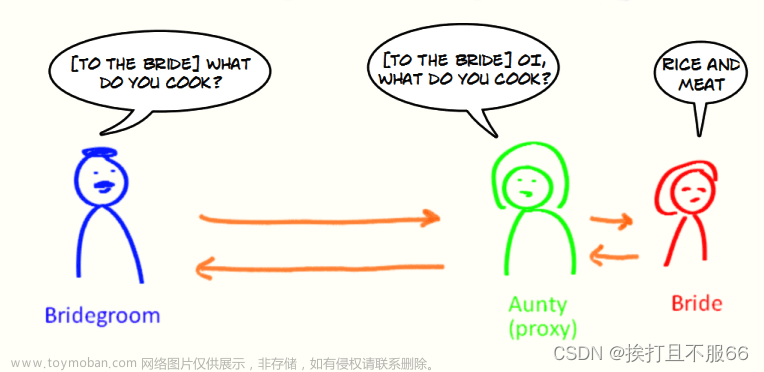1.为什么说JDK动态代理必须要实现当前父接口才能使用
JDK动态代理是基于接口的代理,它要求目标类(被代理的类)必须实现一个或多个接口。这是因为JDK动态代理是通过创建目标类的接口的代理对象来实现的,代理对象实现了目标接口,并在方法调用时委托给InvocationHandler中的invoke方法来处理。
在JDK动态代理中,Proxy类的newProxyInstance方法接受一个ClassLoader,一组接口和一个InvocationHandler,然后生成一个代理类的实例。这个代理类实例实现了指定的接口,并将方法调用委托给InvocationHandler中的invoke方法。
自我结论:可能是因为比如生成的$Proxy代理类如果没有父接口 那他内部也不知道通过InvocationHandler来调用谁来进行增强了 还有就是可能有一些决策问题。
2.JDK动态代理的$Proxy实现
Cat父接口
//父接口 interface Cat { //开车 void drive(); //下车 void off(); }
interface InvocationHandler { //代理类,代理方法,代理方法参数 Object invoke(Object proxy, Method method, Object[] args) throws Throwable; }
class $Proxy0 implements Cat { private InvocationHandler invocationHandler; private Map<String, Method> methods; public $Proxy0(InvocationHandler invocationHandler) { this.invocationHandler = invocationHandler; this.methods = new HashMap<>(); try { methods.put("drive", Cat.class.getMethod("drive")); methods.put("off", Cat.class.getMethod("off")); } catch (NoSuchMethodException e) { throw new RuntimeException(e); } } @Override public void drive() { try { invocationHandler.invoke(this, methods.get("drive"), new Object[0]); } catch (Throwable e) { throw new RuntimeException(e); } } @Override public void off() { try { invocationHandler.invoke(this, methods.get("off"), new Object[0]); } catch (Throwable e) { throw new RuntimeException(e); } } }
class CustomLogicHandler implements InvocationHandler { private Object target; private Map<String, Runnable> methodEnhancements; public CustomLogicHandler(Object target) { this.target = target; this.methodEnhancements = new HashMap<>(); methodEnhancements.put("drive", () -> System.out.println("开车增强")); methodEnhancements.put("off", () -> System.out.println("下车增强")); } public Object invoke(Object proxy, Method method, Object[] args) throws Throwable { // 根据方法名获取增强逻辑 Runnable enhancement = methodEnhancements.get(method.getName()); if (enhancement != null) { enhancement.run(); } // 委托给目标对象执行原方法 Object result = method.invoke(target, args); return result; } }
Fute实现类(待增强类)文章来源:https://www.toymoban.com/news/detail-777064.html
class FuTe implements Cat { @Override public void drive() { System.out.println("我要开始开车了"); } @Override public void off() { System.out.println("我要下车了"); } public static void main(String[] args) { Cat realObject = new FuTe(); CustomLogicHandler customLogicHandler = new CustomLogicHandler(realObject); Cat proxyObject = (Cat) new $Proxy0(customLogicHandler); proxyObject.drive(); System.out.println("------"); proxyObject.off(); } }
总结:在这个例子中,CustomLogicHandler中的methodEnhancements存储了不同方法的增强逻辑,而不再使用if语句。在$Proxy0中的methods也类似地存储了不同方法的Method对象。这种方式可以更灵活地处理不同方法的增强逻辑,而不需要使用大量的if语句。文章来源地址https://www.toymoban.com/news/detail-777064.html
到了这里,关于通过JDK动态代理类实现一个类中多种方法的不同增强的文章就介绍完了。如果您还想了解更多内容,请在右上角搜索TOY模板网以前的文章或继续浏览下面的相关文章,希望大家以后多多支持TOY模板网!










